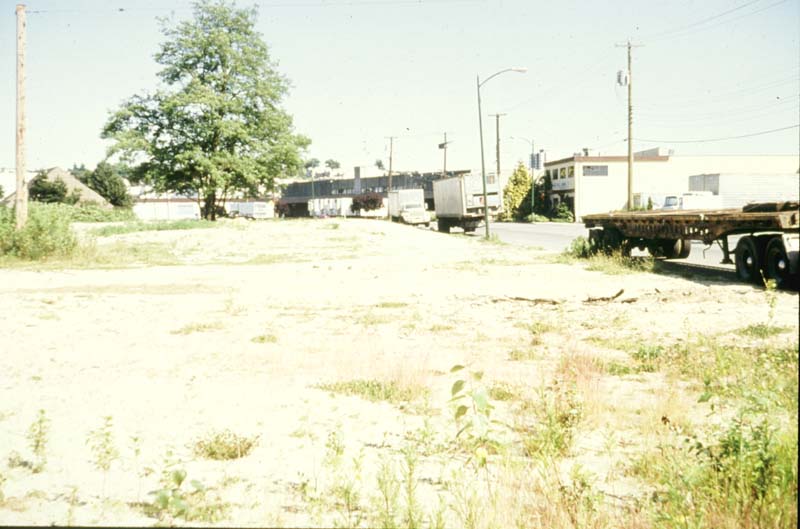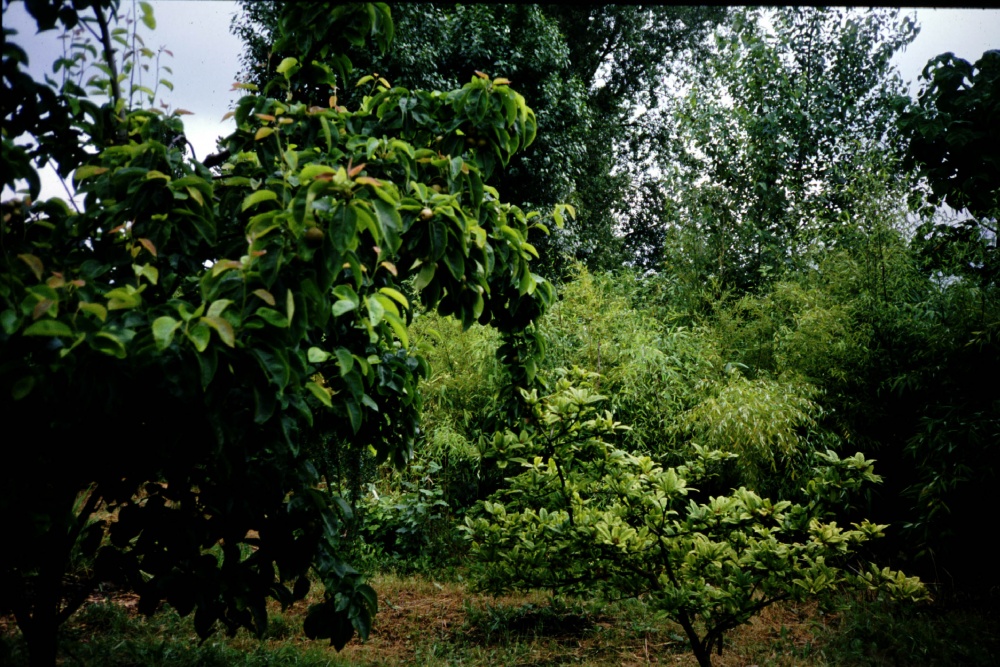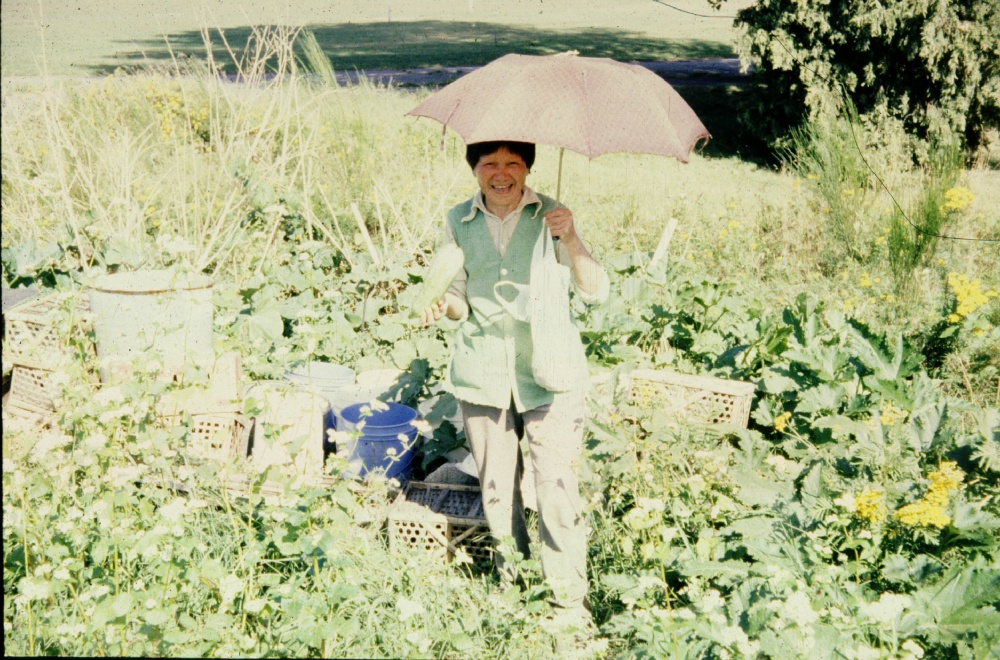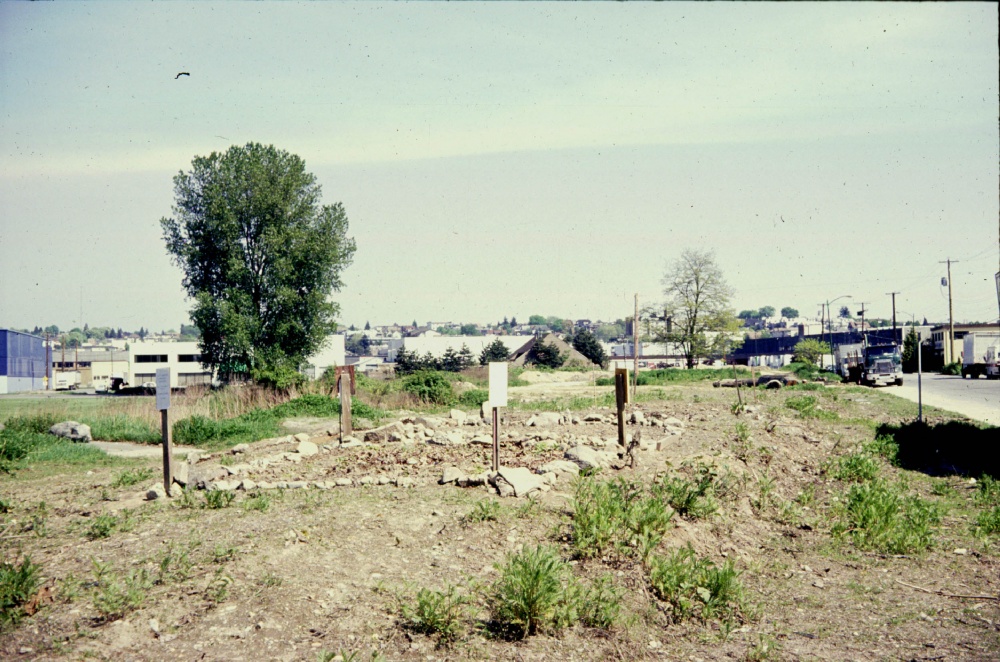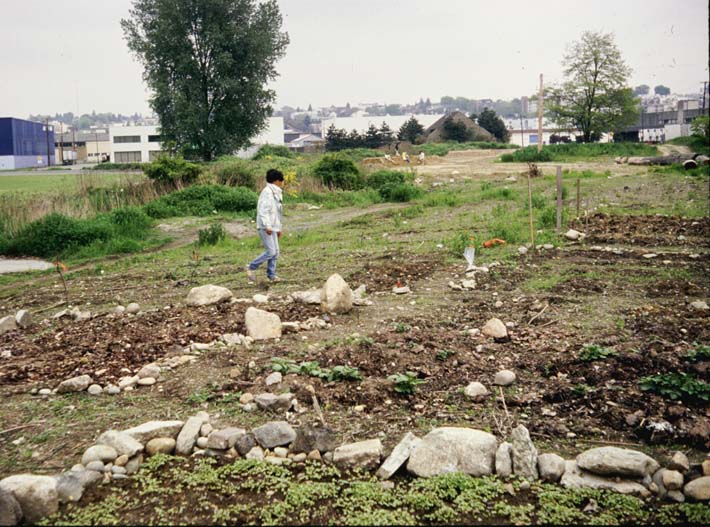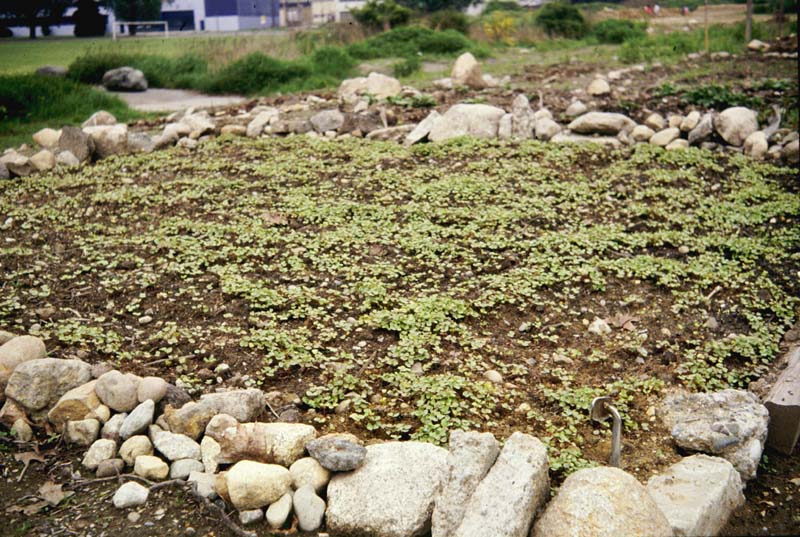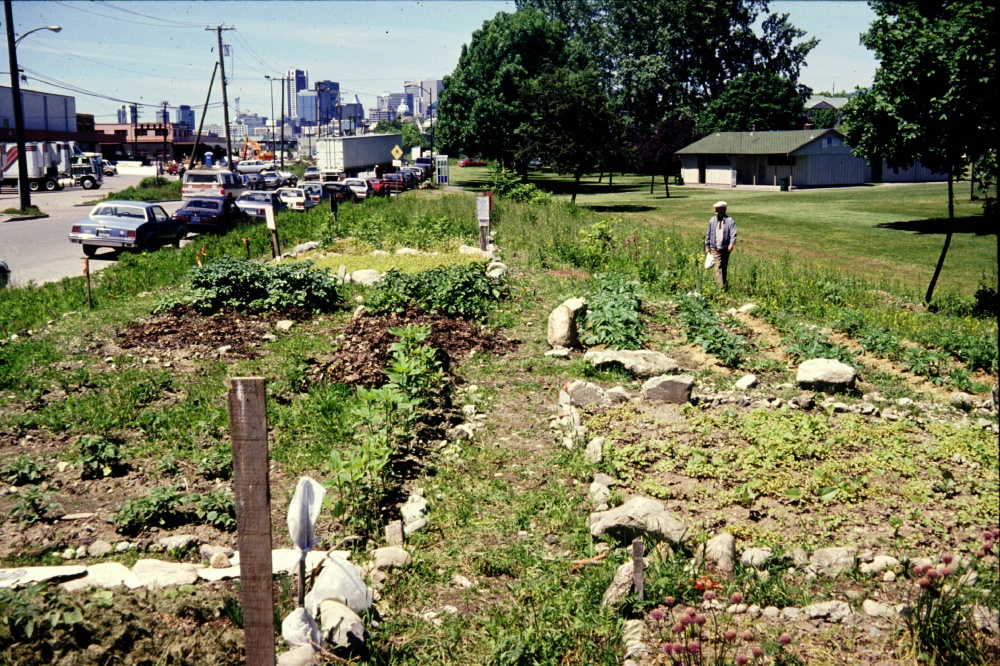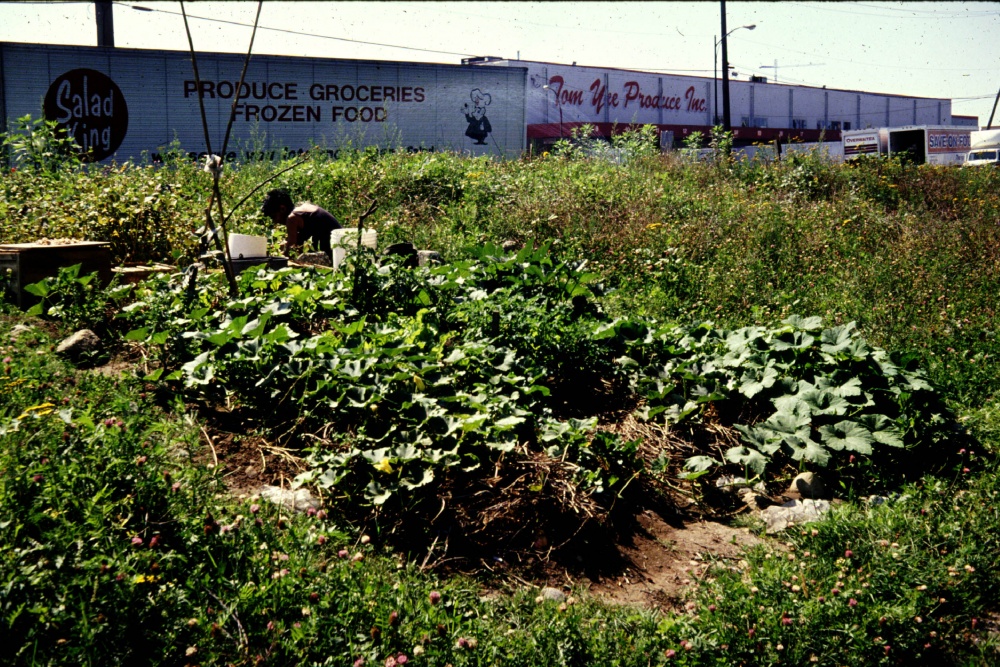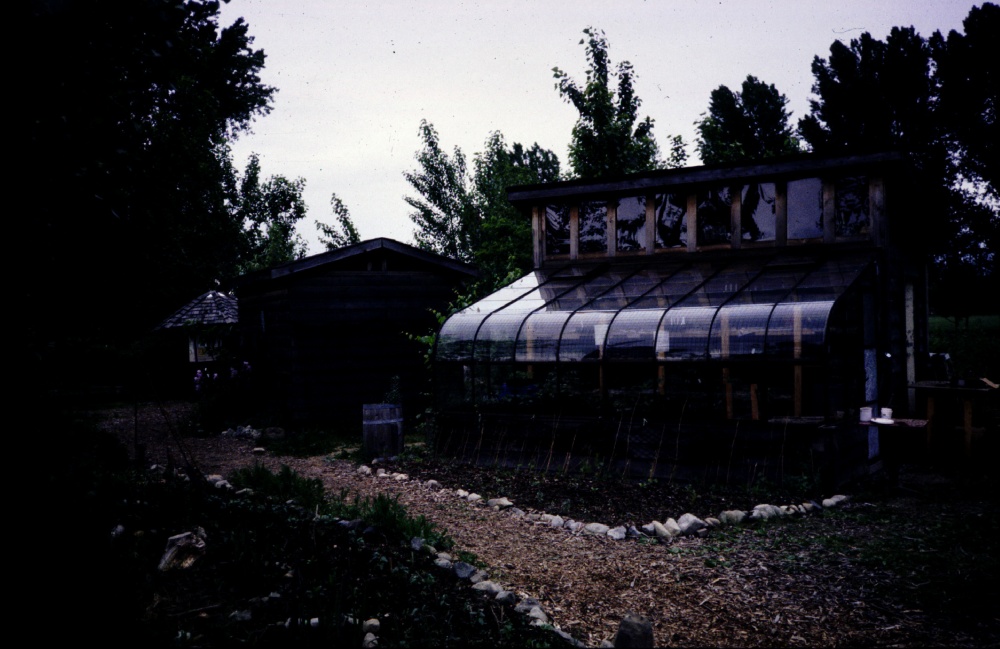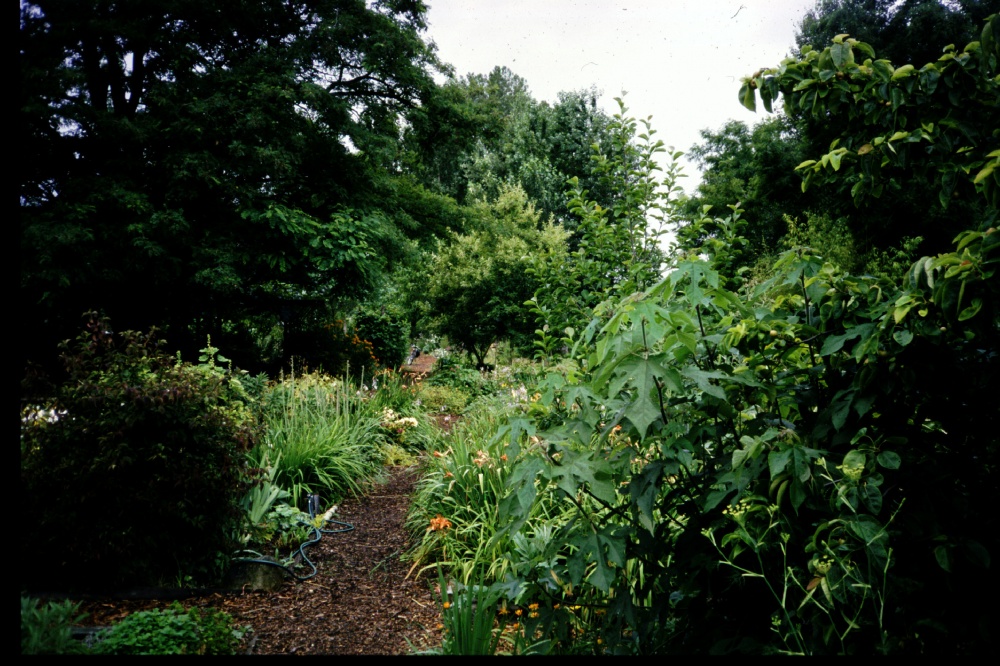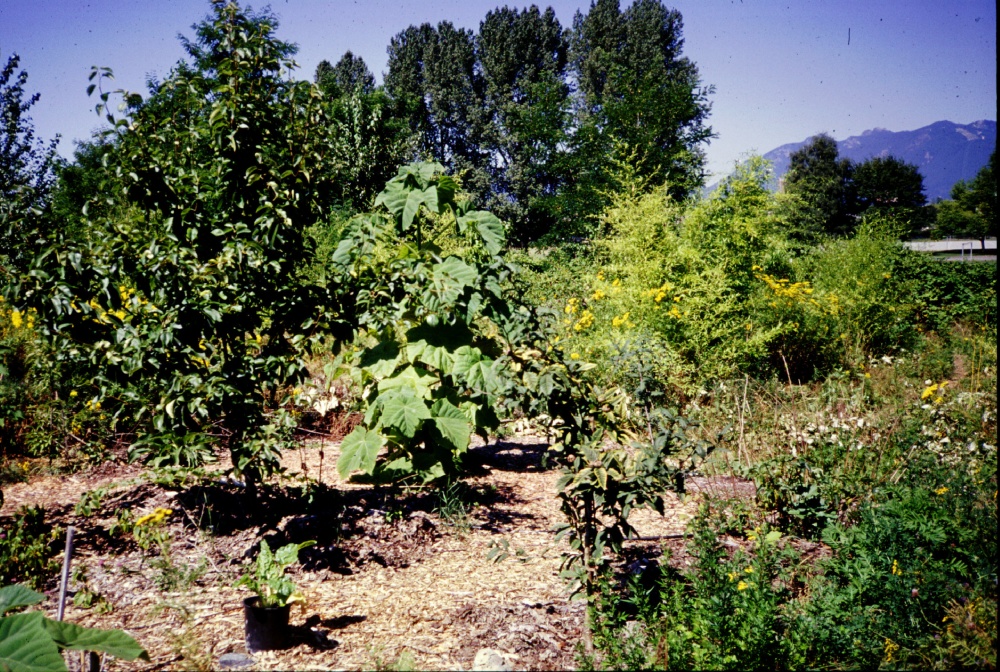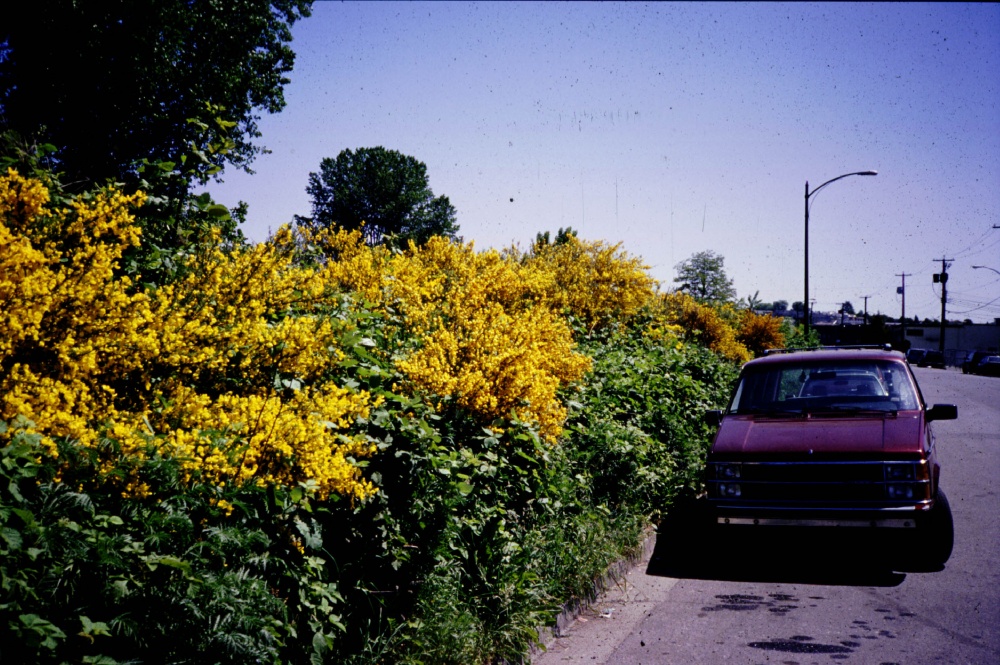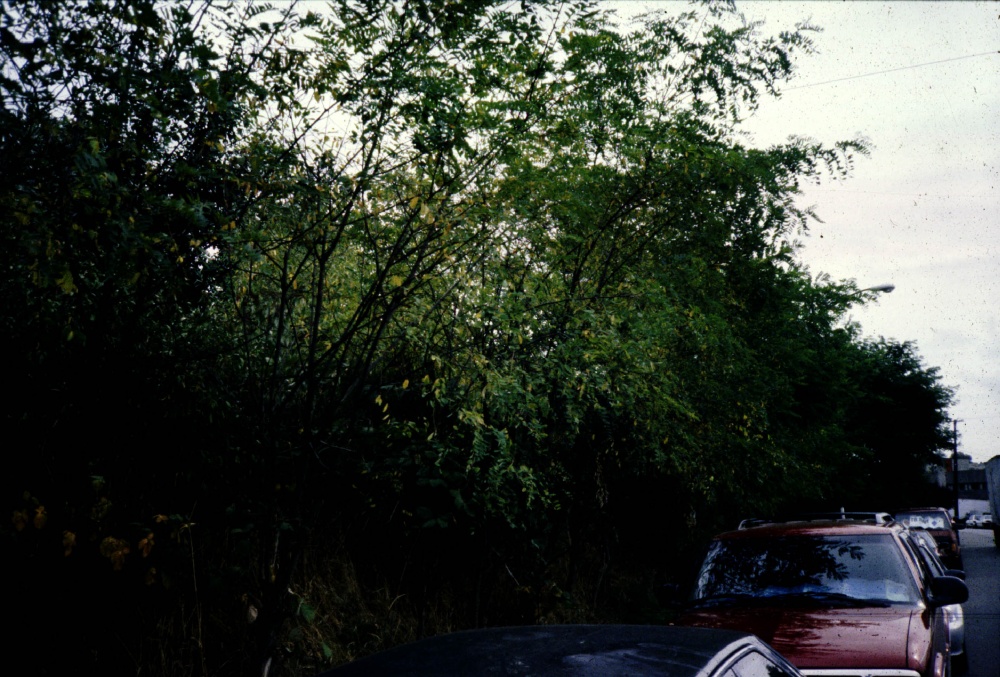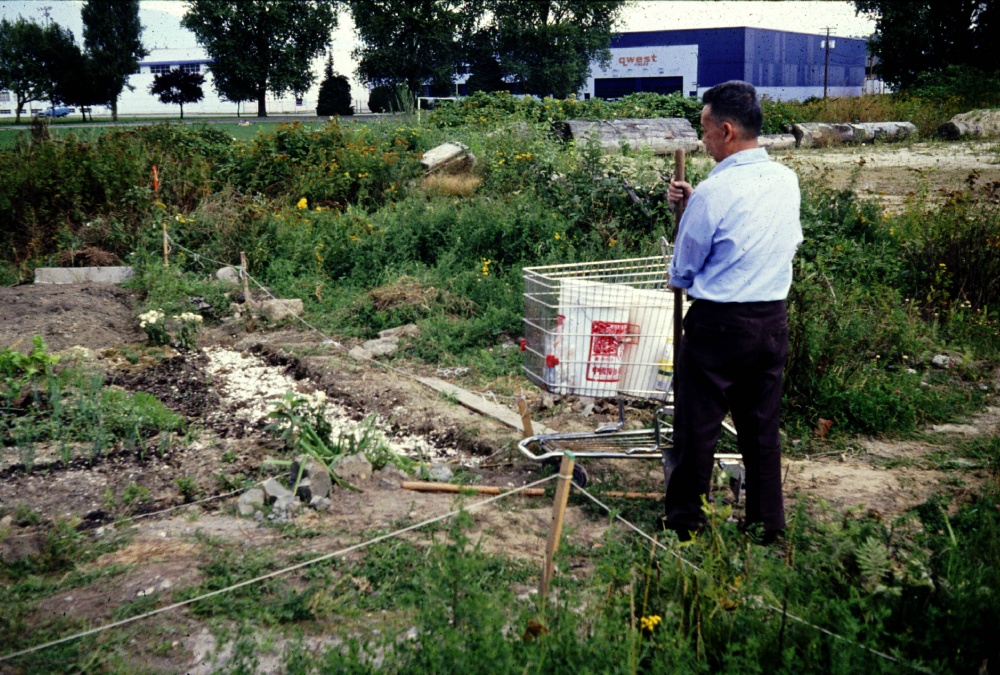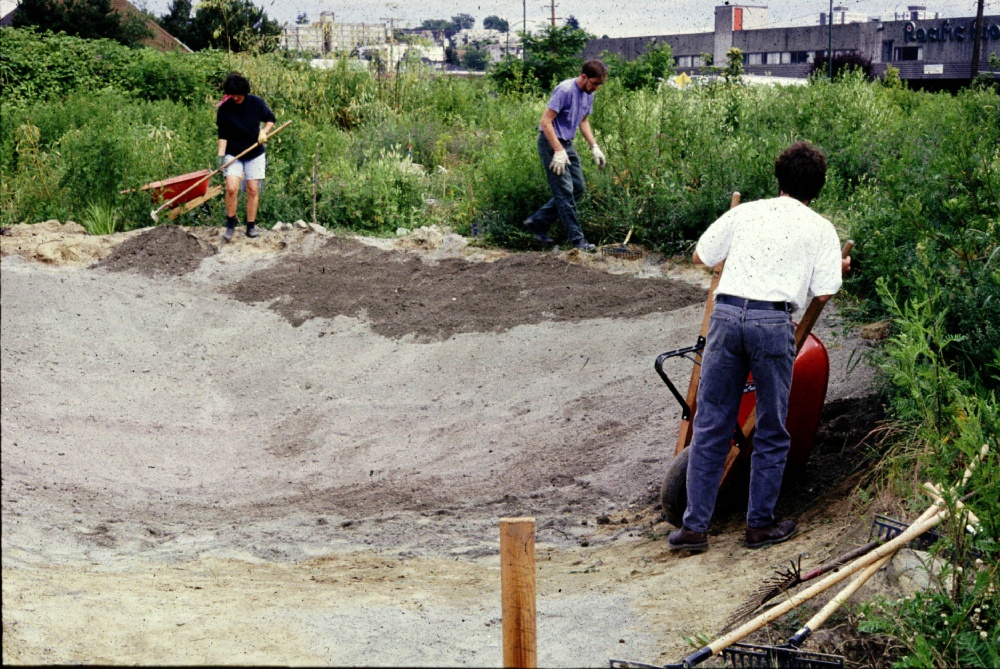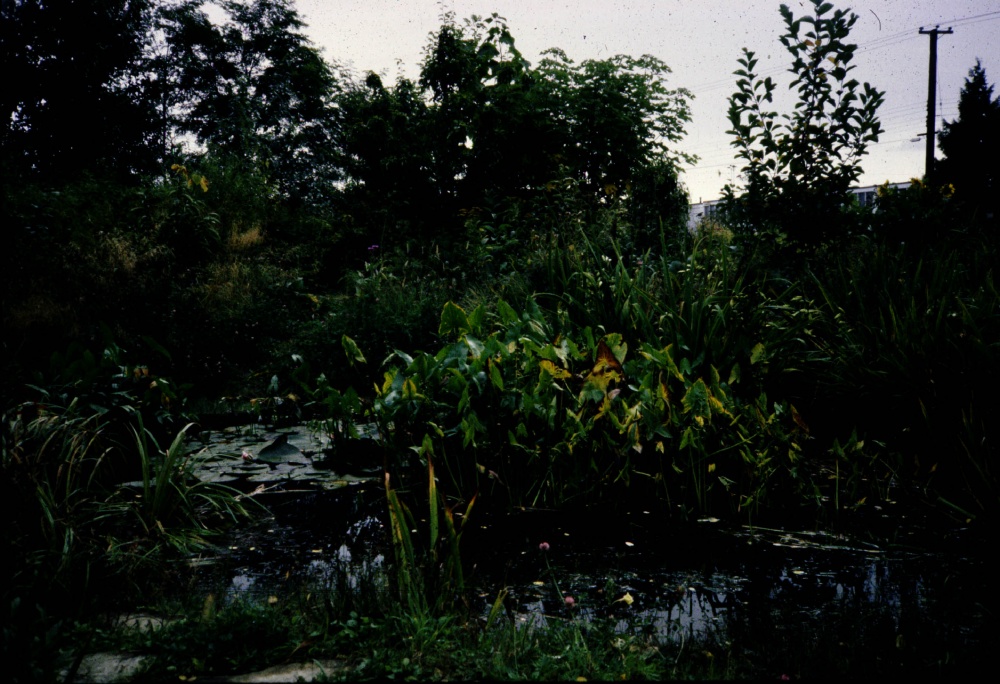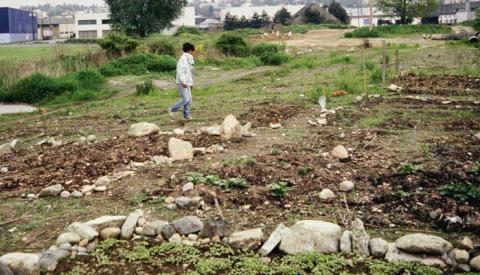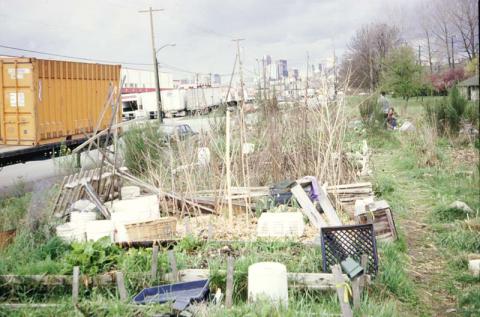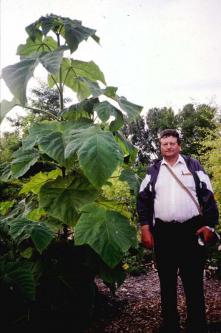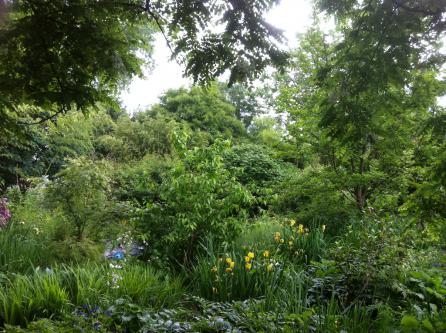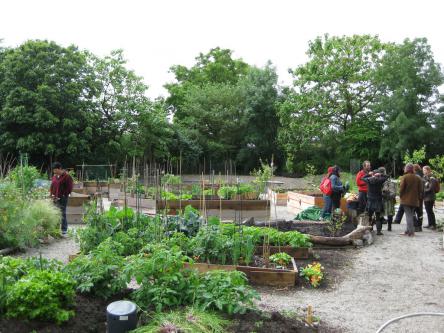Cottonwood Community Gardens
After moving from Toronto to Vancouver in the late 1980’s, I became part of East Vancouver's nascent guerrilla gardening movement. I joined the board of the newly founded Strathcona Community Gardens at the time when a large portion of it had been expropriated to build a senior’s housing complex. The consequent reduction in garden space meant that plots could no longer be provided to all those who wanted them and a waiting list was starting to build. I decided to spearhead a squatting initiative to annex a nearby vacant city property so that we could have more garden space. The land in question, a 3-acre strip along the south edge of Strathcona Park, was under the joint jurisdiction of the Vancouver Parks Board and the City Engineering Department who maintained half of it as a right-of-way along Malkin Ave.
It was a poorly kept secret at the time that City Engineering was actively considering routing a freeway (which they billed as a 'truck route') through the Grandview Cut (see Healing the Cut/Bridging the Gap), which would have had the effect of funnelling heavy traffic into the downtown core via Malkin and effectively marooning Strathcona Park between two high speed traffic corridors. As well as acquiring precious garden space, I figured that getting people to physically occupy the Malkin Avenue right-of way would be a useful impediment to the building of the freeway, which many of us in the neighbourhood considered unsustainable and a threat to community well-being.
Together we decided to arrange our plots into a simple grid pattern on either side of a central pathway, to give ourselves easy access to the public washrooms of the park’s field house, from where we had to haul water in buckets to irrigate our crops. Though conceived of as an annex to the Strathcona Gardens, we named our initiative ‘Cottonwood Gardens’ in reference to the massive cottonwood trees that grow nearby. These trees are landmarks and are visible from right across the city.
These first days were heady with excitement but also quite hard going. The land had been used as an informal dump site for years and the ground was littered with garbage and construction debris as well as the detritus from the neighbourhood’s thriving sex and drug trades including the empty Lysol cans drained by alcoholics, discarded condoms and hypodermic syringes. To make things worse, grey market building contractors and landscapers were still dumping their waste at night, sometimes right on top or our gardens, as the city authorities were then lax in enforcing anti-littering bylaws in the city's East end. Consequently our ad hoc group spent a lot of time cleaning up, filling dumpsters with the garbage we collected and enlisting various churches and volunteer societies to help us in this task. The clean up was enthusiastically supported by nearby businesses, some of whom even gave us on-the-spot, cash donations so we could buy more wheelbarrows and shovels.
By the end of the first season, Cottonwood had evolved into a fully-fledged guerrilla garden, with a network of paths, garden plots and common areas laid out, albeit in a rough-and-ready manner. But there were still those at City Hall who were critical of our efforts, viewing what we were doing as a dangerous precedent and an unsanctioned occupation of public property. A struggle soon ensued between some city staff, primarily from the Engineering Dept., who wanted to evict us, and others, including several city counselors and Parks Board employees who saw what we were doing as a laudable example of grassroots community empowerment.
Perhaps I should provide some historical context: Vancouver City Council at that time was polarized between the majority, right-leaning, Non-Partisan Alliance and the left-of-center Coalition of Progressive Electors, who garnered the bulk of their votes from the lower income, East Side neighbourhoods. There had long been a sense in the East Side that we suffered under a kind of ‘recreational apartheid,’ due to our predominant support for COPE. We felt we generally got the short end of the stick when it came to the city's investment in the area's parks and public facilities, and we resented having to lobby hard to get simple things like teeter-totters in the parks for the kids while at the same time watching multi-million dollar, beach-front properties get acquired for wealthier neighbourhoods such as Kitsilano and West Point Grey. Together with a possé from the Strathcona Gardens, the Cottonwood crew started pushing, not only for official recognition, but for a long-term lease that would ensure us security of tenure and the ability to plan ahead so we could build the permanent infrastructure we so needed. After a tumultuous public meeting, City Council granted us a lease, thanks largely to the support of COPE's Libby Davis who championed our cause, and, it needs to be said, a few key NPA members who decided no longer to oppose us.
Hot on the heels of this success, we received grants from the Vancouver Foundation and the Vancity Envirofund. These enabled us to install such important infrastructure as an irrigation system, a garden shed (with attached greenhouse for starting seedlings) and a pond to store rain water and attract wildlife. We also used the money to purchase nursery stock to incorporate into our public plantings, notably the Asian arboretum and the Kiwi arbor.
This period of intense activity attracted even more participants and it was during this time that members of the Environmental Youth Alliance started to help us out at work parties as well as founding their own youth garden at the property’s eastern periphery. The youth garden went on to become the focus for a wide variety of educational activities, which brought many high school students and young environmental activists into the Cottonwood community. EYA's consistency throughout the ebbs and flows of our own volunteer energy proved essential to Cottonwood's continued development.
A lot of the work I did during this initial pioneering period was to initiate and preside over an interactive, co-design process that would allow Cottonwood to evolve naturally, while meeting the needs of its diverse stakeholders – human and non-human. As well as spending a lot of time observing the natural processes of recovery that were already happening on the land, I interviewed most of the gardeners, many of whom didn’t use English as their primary language, to get a sense of the aspirations they had for how Cottonwood should develop. I used simple community mapping techniques, where I distributed maps to the gardeners showing the outlines of the property and had them sketch in where they thought key elements such as paths, structures and common areas should go. Using this technique, I was surprised at how much people already agreed on, so in the end it was possible to do a lot of the design work with a minimum of formal meetings, which many of people would have anyway been reluctant to attend.
Over the years, Cottonwood has emerged as a template for a new kind of interactive, public landscape. It balances the need for encouraging private initiative via the individual garden plots, where people can do more or less as they please, (except use chemicals or impinge on their neighbours), with the necessity for communally managed, public areas benefiting everyone that uses them and as well as the surrounding community. Getting this balance right was I believe, a key factor in ensuring Cottonwood’s longevity
Previous to the Cottonwood project, I spent a fair amount of time researching the principles of permaculture. Permaculture is a design philosophy that mimics the relationships found in natural ecosystems with the aim of creating more sustainable agricultural and human settlement strategies. This turned out to be a useful approach for the many vexing problems posed by Cottonwood’s socially and ecologically complicated situation. Sheet mulching, for example, is a well known permaculture technique that increases soil fertility by emulating the way forests accumulate humus through the deposition of woody biomass. We used sheet mulching extensively, especially in the Asian arboretum, where we needed to build soil and conserve precious moisture to allow trees to grow. The technique was to cover the dry, compacted ground with overlapping sheets of cardboard and a thick layer of wood chips and then water it well. Soon we witnessed a substantial increase in the rate of tree growth and it wasn't long before we started enjoying abundant harvests of mulberry, Asian pear, persimmon, Shiro plum and Sansho (a Japanese variant of Szechuan Pepper.)
Simulating the way a forest grows was also a key strategy in managing the earth berm we installed along Malkin Avenue. We needed to do this in order to curb the dumping of garbage that was still occuring as well as to direct the flow of pedestrians through the main entrance ways thereby also discouraging vandalism and the pilfering of our produce.To build the berm, we flagged down several dump trucks hauling fill from a nearby excavation site. The dump truck drivers happily deposited their loads in a long mound along Malkin Ave., which we shaped with rakes and shovels. It was clear from the get-go that we needed to find a way to keep the soil from falling onto the street. We did this by planting Scotch Broom, dug up from other parts of the garden, with the idea that its rampant roots would soon hold together the unstable soil. Though planting the invasive broom seemed heretical to the more horticulturally inclined, the hardy shrubs soon did their job, stopping the erosion and shielding the bare soil from wind and rain with a thick, weedy verdure. But we didn’t want the broom to take over and seed itself into our garden plots.
To prevent this, I applied the permaculture principle of ‘accelerating succession’ by planting dozens of black locust (Robinia) seedlings in amongst the broom with the plan that the locust trees would eventually over-top the more shrubby broom bushes and shade them out. This worked quite quickly, with the added benefit that black locust is a useful, cyclically harvestable crop that furnished us with rot-resistant wood, useful for fence posts, bean teepees and other garden structures. Once cut, the trees grow back readily from the own roots - a principle called coppicing. Black locust flowers also attract bees, whose presence helped to pollinate other plants in the gardens, giving us increased yields. A further benefit was the delicate shade cast by the trees’ overarching foliage, which made the adjacent stretch of Malkin Avenue a cool and pleasant place for the workers at the nearby produce warehouses to park their cars.
Our proximity to the Malkin Avenue produce warehouses proved to be one of the most important assets of the Cottonwood site. This conglomeration of wholesalers is one of the largest trans-shipment point for fruits and vegetables on the West Coast and with the massive volume of produce handled every day and the long distances it has traveled, a fair amount of spoilage happens. This meant that unlimited quantities of compostable material were available to us for free, from the nearby dumpsters, which substantially sped up our soil building efforts. Sometimes the produce workers even deliver fork lift loads of rotten produce right to our composting facility, where our dedicated volunteers processed it in wire mesh cylinders, which could be easily undone when the compost needed turning.
As well as providing us with free soil nutrients, having the presence of the wholesalers provided us and the public with a powerful object lesson in food sustainability. Twenty-four hours a day, produce-laden trucks and tractor trailers would be parked beside the gardens, their refrigeration units roaring and belching smoke, waiting their turns to off load. On several occasions, drivers walking through the garden to stretch their legs after a long drive, remarked to me that they found it ironic we were growing produce a few metres from their idling rigs that looked as good as what they had just brought in from hundreds if not thousands of kilometres away. In its role as social sculpture, Cottonwood was already doing its job.
It’s now been almost 20 years since I installed that very first garden plot on the garbage-strewn wasteland that would eventually transform into the oasis of greenery it is today. So many surprising things happened over the years, many of them directly attributable to the energy and hard work of the many generous people involved, but there were also transformations of a more subtle, less directly attributable kind. I don’t know exactly how to put this, but nature itself seemed to approve of our efforts as we went along, in ways that were at times quite astonishing. For example, when vegetation first started coming back to what had been a bare and dusty expanse, we were suddenly overrun by a plague of rats. They fed voraciously on our crops and alarmed us as they leaped up from the tall grass. Then one spring, in the midst of our despair over a seemingly insoluble vermin situation, a pair of red-tailed hawks appeared and proceeded to build an enormous, twiggy nest in one of the large cottonwood trees. For the rest of that summer, they hunted the rats relentlessly to feed their chicks and it wasn't long before the problem was completely under control.
As if by magic, nature had intervened to rectify an imbalance. The hawks continued to use the same nest for many more years until eventually a pair of magnificent bald eagles pre-empted them, adding to the nests already substantial mass with their own contributions of sticks and detritus. Seeing these archetypal, massive raptors banking over the factories and playing fields of this inner city neighbourhood was as uplifting as it was incredible. I'd like to think that all the hard work we did to restore this ravaged piece of land to ecological functionality was a necessary precondition for these birds to arrive. It is clear that our attention to building wetland and shrub habitats paid obvious dividends that included a marked increase in song birds, butterflies and the reappearance of tree frogs and garter snakes where they had long been absent.
Looking at Cottonwood now, it is hard to imagine its bleak beginnings. Back all those years ago, I didn’t have any great, overarching vision of what could happen - just a hunch that this sad and abused piece of terrain vague could somehow be transformed into something better. The ensuing collaboration that occurred between a diverse, highly individualistic group of people and the restorative forces of nature still amazes me. I am proud to have been able to play a part in founding and I am equally proud that scores of other people, many of whom I don’t even know, are still feeling it worthwhile to keep it going. The Cottonwood experience has nourished me far more than has any art project I've ever done. It has changed the way I look at the world and given me hope. In the intervening years, several of the founding guerrilla gardeners have passed on - some of them much too young. Yet their legacy lives on in this flourishing garden. I think of them often.
Slide Show:
projects:
events:
-
Thursday, March 20, 2025 - 12:00 - 13:00
-
Tuesday, April 26, 2022 - 03:30 - 16:30
-
Friday, April 1, 2022 - 18:00 - Monday, April 4, 2022 - 12:00
-
Friday, April 1, 2022 - 09:00 - Sunday, July 31, 2022 - 17:00
-
Wednesday, December 8, 2021 - 21:45 - 22:45
-
Friday, November 5, 2021 - 13:45 - 16:00
-
Tuesday, October 12, 2021 - 13:30 - 14:15
-
Monday, June 28, 2021 - 10:00 - 11:00
-
Thursday, March 19, 2020 - 12:00 - Sunday, March 22, 2020 - 00:00
-
Friday, October 25, 2019 - 21:00 - Sunday, October 27, 2019 - 23:00
-
Thursday, August 1, 2019 - 12:00 - Wednesday, October 2, 2019 - 00:00
-
Friday, April 26, 2019 - 21:30 - Saturday, April 27, 2019 - 00:30
-
Friday, March 29, 2019 - 23:00 - Sunday, March 31, 2019 - 21:00
-
Sunday, June 24, 2018 - 12:00 - Saturday, July 7, 2018 - 22:00
-
Friday, June 22, 2018 - 12:00 - Sunday, September 30, 2018 - 20:00
-
Saturday, June 9, 2018 - 12:00 - 19:00
-
Saturday, May 19, 2018 - 15:00 - Sunday, November 11, 2018 - 22:00
-
Sunday, April 22, 2018 - 13:00 - 23:00
-
Friday, April 13, 2018 - 22:00 - Sunday, April 15, 2018 - 17:00
-
Friday, January 26, 2018 - 09:30 - 11:00
-
Saturday, July 1, 2017 - 03:00 - Sunday, August 27, 2017 - 03:00
-
Friday, May 26, 2017 - 12:00 - Saturday, May 27, 2017 - 15:00
-
Sunday, May 14, 2017 - 13:00 - 17:00
-
Sunday, April 30, 2017 - 20:00 - 22:30
-
Sunday, April 9, 2017 - 18:00 - 20:00
-
Tuesday, November 15, 2016 - 14:00 - 16:00
-
Tuesday, April 12, 2016 - 17:00 - 18:30
-
Tuesday, March 1, 2016 - 12:00 - Monday, June 6, 2016 - 21:00
-
Thursday, February 25, 2016 - 14:15 - 14:30
-
Tuesday, February 16, 2016 - 14:15 - Wednesday, February 17, 2016 - 00:45
-
Wednesday, December 2, 2015 - 22:00 - Sunday, December 6, 2015 - 22:00
-
Saturday, November 21, 2015 - 19:00 - 21:00
-
Friday, September 18, 2015 - 03:00 - Monday, December 7, 2015 - 02:59
-
Saturday, May 16, 2015 - 16:00 - 19:00
-
Friday, April 17, 2015 - 19:00 - Saturday, April 18, 2015 - 22:00
-
Wednesday, February 25, 2015 - 03:00 - Wednesday, March 25, 2015 - 03:00
-
Tuesday, November 11, 2014 - 20:00 - Wednesday, November 12, 2014 - 00:00
-
Monday, September 22, 2014 - 12:00 - Sunday, September 28, 2014 - 02:00
-
Wednesday, July 30, 2014 - 12:00 - Monday, August 4, 2014 - 01:00
-
Tuesday, July 22, 2014 - 13:00 - Friday, July 25, 2014 - 19:00
-
Wednesday, March 19, 2014 - 21:00 - 22:00
-
Saturday, March 15, 2014 - 12:00 - Friday, March 28, 2014 - 12:00
-
Thursday, March 6, 2014 - 19:00 - 21:00
-
Tuesday, February 25, 2014 - 14:00 - 15:15
-
Friday, October 25, 2013 - 11:30 - Saturday, October 26, 2013 - 19:00
-
Saturday, September 28, 2013 - 20:30 - 23:30
-
Monday, September 16, 2013 - 03:00 - Wednesday, September 25, 2013 - 02:59
-
Sunday, May 26, 2013 - 18:00 - 21:00
-
Saturday, May 25, 2013 - 14:00
-
Thursday, May 9, 2013 - 18:00
-
Thursday, February 21, 2013 - 22:00 - Friday, February 22, 2013 - 00:00
-
Thursday, February 7, 2013 - 17:00 - 19:00
-
Tuesday, December 4, 2012 - 22:30
-
Sunday, September 30, 2012 - 21:30 - Monday, October 1, 2012 - 00:00
-
Wednesday, September 26, 2012 - 20:00 - Thursday, September 27, 2012 - 00:00
-
Saturday, August 25, 2012 - 16:00 - 19:00
-
Friday, June 1, 2012 - 14:00 - 16:00
-
Friday, February 17, 2012 - 21:00
-
Thursday, January 26, 2012 - 15:00 - 17:00
-
Friday, November 18, 2011 - 21:30 - Monday, November 21, 2011 - 00:00
-
Sunday, September 18, 2011 - 13:00
-
Saturday, September 17, 2011 - 13:00 - 17:00
-
Saturday, June 25, 2011 - 13:00
-
Thursday, June 23, 2011 - 22:00
-
Wednesday, June 22, 2011 - 22:00
-
Thursday, May 5, 2011 - 22:00
-
Thursday, October 28, 2010 - 22:00 - Friday, October 29, 2010 - 01:00
-
Tuesday, June 1, 2010 - 21:00 - Wednesday, June 2, 2010 - 00:00
-
Friday, April 16, 2010 - 23:00
-
Wednesday, March 31, 2010 - 22:00 - Thursday, April 1, 2010 - 00:00

